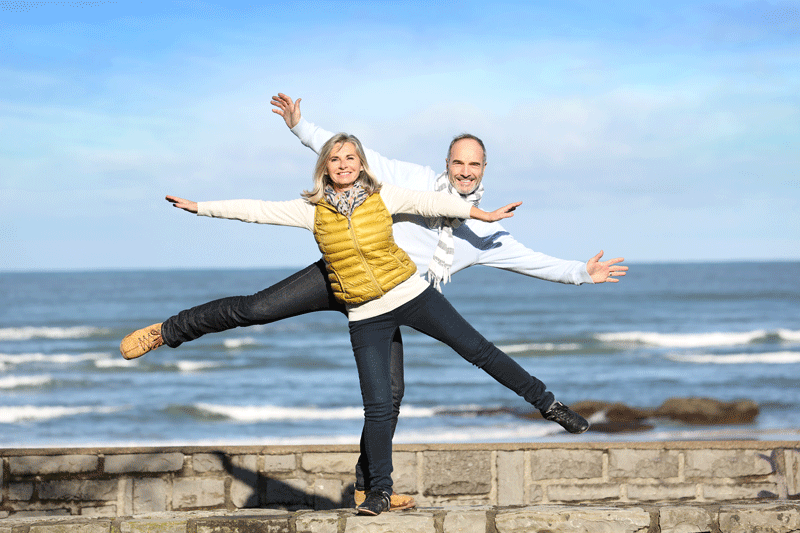
30 Nov Stand Tall and Don’t Fall
Here we are in the midst of the gorgeous fall season. I look forward each year to the sensory awakening I get when I see the brilliant explosion of red, yellow, orange, and ochre take over the leaves here in the Pacific Northwest.
But unfortunately, my enjoyment of the last three fall seasons has been ironically disrupted by actual falls. You know, the ones that leave you black and blue.
As someone who trains people over 50 in fall prevention strategies in my Octane for the Brain workshops, can you imagine how it feels to walk into the classroom or hobble across a stage to speak about caring for your brain and staying healthy when I’m decked out with colorful bruises, plaster casts, and revolting crutches? The last thing I want to do is present myself as the poster child for “what not to do to prevent falls!” But stuff happens, right? However, why during the ‘fall season’, and why three years in a row? (It feels like getting ‘three strikes!’)
Regrettably, we can be standing tall and poised one minute, and then within the blink of an eye, we feel our balance suddenly give way to some quirky force of gravity. And we hit the ground with a thud. As we struggle to get up and compose ourselves, we hope no one saw witnessed such an ungraceful event.
Funny…I have no problems remaining balanced and upright while unpredictable horses, but my nemesis the past few years is just walking normally and climbing stairs. I’m done with spending three holiday seasons walking into physical therapy clinics for treatment. I’m done with that!
I decided that this fall season, I’m going to more actively practice what I preach as I grow older. I’m 100% committed to staying vertical in the days ahead. And so far…so good. I’ve tossed some fabulous, but risky, too-high heels into a donation bag, and I’m making sure I now carry my computer gear in a backpack rather than a shoulder bag causes my balance to go haywire. Trendy bags and shoes look great, but I realize they simply aren’t worth the resulting fall injuries. I have also learned to slow down my habit of speeding up and down stairs to get somewhere faster. Time can wait. I’m grasping the the rails and taking each step with great intention.
As a result, my balance has improved immensely. I enrolled in the Silver Sneakers yoga and classic programs at my local gym. What an amazing difference that program has made in my posture, movement, and ability to balance. I’m actually able to maintain balance during intricate “half moon yoga pose,” these days. (If you want to stay healthy enough to rock your 50s and beyond… stay tuned for a soon-to-come blog about the amazing benefits of the Silver Sneakers program for people 65+.)
Older Adult Fall Prevention Has Become a Public Health Challenge
According to the National Safety Council, one in three adults over the age of 65 will fall each year. Sadly, falls have become the number one cause of injury and death among older Americans. Think about this… Just one trip and fall can become the difference between spending your retirement years focused on travel, pleasure, and physical activity…or coping with a future diminished by immobility and health challenges.
Why Are Falls More Common As We Grow Older?
There are four key hazardous areas that lead to age-related falls. Learn more about them below.
- Physical Inactivity
As the candles increase on our birthday cakes, physical inactivity too often follows. As a result, thousands of deaths occur each year. When we are inactive, our bodies lose muscle stability and mass. (Potentially we lose bone mass as well.) Without strong, evenly distributed muscles the ability to maintain balance decreases and falls are the likely result.
- Poor Posture
Over time, the way we walk and stand changes. The length of our steps shortens, our heads drop forward, and our shoulders tend to slump as we age. This “elderly” posture impacts our steadiness as well as our ability to scan the horizon for potential trip hazards. Senior community centers are a great place to find balance classes that help you become more aware of your posture and fall prevention and safe navigational strategies.
- Vision Problems
As we grow older, our eyes tend to slow down as we aim to adjust to changes in light. It is important to check our home lighting. Consider the importance of using night lights and flashlights when walking through the house or around the property during evening hours.
Eye doctors and practitioners also recommend that we get our eyesight checked a minimum of every two years. It is also important to be screened for cataracts, glaucoma, and macular degeneration and other things that can interfere with our vision and cause falls.
- Medication Side Effects
Adults who take four or more medications at a time are at highest risk for falling. But certain types of drugs can also increase fall risks as we age. Sleep aids, cold medicines, pain killers, anti-depressants, and allergy medications often cause drowsiness and dizziness. It is important to discuss fall risks associated with the medications you take with your health practitioners.
Researchers have discovered that the “common denominator” among the drugs mentioned above is that they all depress the central nervous system and slow down our ability to react to fall hazards.
Stay Steady On Your Feet By Viewing These Fall Prevention Resources
How’s your balance working out for you currently? If you want to stay empowered and rock your 50s and beyond, you need to make sure falls don’t lay you low and immobilize you or cause an injury to your brain.
Take a look at the resources provided below. The checklists will help you assess fall risks in your environment. Join me in a crusade to stay vertical through not only the remained of this ‘fall season’…but through all the seasons of the year.

Andrea
Posted at 21:30h, 07 FebruaryHello! wonderful article 🙂 As a 50+ yoga teacher, it’s incredible how the benefits of yoga, especially balancing, can carry over into everyday activities. And you can practice yoga balance poses anywhere, any time during your day, it doesn’t have to be on a yoga mat.